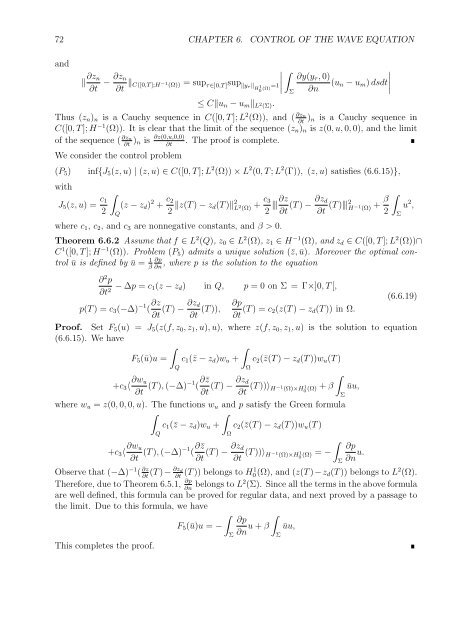Optimal Control of Partial Differential Equations
Optimal Control of Partial Differential Equations
Optimal Control of Partial Differential Equations
You also want an ePaper? Increase the reach of your titles
YUMPU automatically turns print PDFs into web optimized ePapers that Google loves.
72 CHAPTER 6. CONTROL OF THE WAVE EQUATION<br />
and<br />
∂zn<br />
∂t<br />
− ∂zn<br />
∂t C([0,T ];H −1 (Ω)) = sup τ∈]0,T ]sup yτ H 1 0 (Ω) =1<br />
≤ Cun − um L 2 (Σ).<br />
<br />
<br />
<br />
<br />
Σ<br />
∂y(yτ, 0)<br />
∂n<br />
<br />
<br />
(un − um) dsdt<br />
<br />
Thus (zn)n is a Cauchy sequence in C([0, T ]; L 2 (Ω)), and ( ∂zn<br />
∂t )n is a Cauchy sequence in<br />
C([0, T ]; H−1 (Ω)). It is clear that the limit <strong>of</strong> the sequence (zn)n is z(0, u, 0, 0), and the limit<br />
<strong>of</strong> the sequence ( ∂zn<br />
. The pro<strong>of</strong> is complete.<br />
∂t )n is ∂z(0,u,0,0)<br />
∂t<br />
We consider the control problem<br />
(P5) inf{J5(z, u) | (z, u) ∈ C([0, T ]; L 2 (Ω)) × L 2 (0, T ; L 2 (Γ)), (z, u) satisfies (6.6.15)},<br />
with<br />
J5(z, u) = c1<br />
2<br />
<br />
Q<br />
(z − zd) 2 + c2<br />
2 z(T ) − zd(T ) 2<br />
L 2 (Ω)<br />
where c1, c2, and c3 are nonnegative constants, and β > 0.<br />
c3<br />
+<br />
2 |∂z<br />
∂zd<br />
(T ) − (T )|2H<br />
∂t ∂t −1 <br />
β<br />
(Ω) + u<br />
2 Σ<br />
2 ,<br />
Theorem 6.6.2 Assume that f ∈ L2 (Q), z0 ∈ L2 (Ω), z1 ∈ H−1 (Ω), and zd ∈ C([0, T ]; L2 (Ω))∩<br />
C1 ([0, T ]; H−1 (Ω)). Problem (P5) admits a unique solution (¯z, ū). Moreover the optimal control<br />
ū is defined by ū = 1 ∂p<br />
, where p is the solution to the equation<br />
β ∂n<br />
∂2p ∂t2 − ∆p = c1(z − zd) in Q,<br />
p(T ) = c3(−∆)<br />
p = 0 on Σ = Γ×]0, T [,<br />
−1 ( ∂z ∂zd<br />
(T ) − (T )),<br />
∂t ∂t<br />
∂p<br />
∂t (T ) = c2(z(T ) − zd(T )) in Ω.<br />
(6.6.19)<br />
Pro<strong>of</strong>. Set F5(u) = J5(z(f, z0, z1, u), u), where z(f, z0, z1, u) is the solution to equation<br />
(6.6.15). We have<br />
<br />
<br />
F5(ū)u = c1(¯z − zd)wu + c2(¯z(T ) − zd(T ))wu(T )<br />
Q<br />
+c3〈 ∂wu<br />
∂t (T ), (−∆)−1 ( ∂¯z ∂zd<br />
(T ) −<br />
∂t ∂t (T ))〉 H−1 (Ω)×H1 0 (Ω) <br />
+ β ūu,<br />
Σ<br />
where wu = z(0, 0, 0, u). The functions wu and p satisfy the Green formula<br />
<br />
<br />
c1(¯z − zd)wu + c2(¯z(T ) − zd(T ))wu(T )<br />
Observe that (−∆) −1 ( ∂z<br />
∂t<br />
Q<br />
+c3〈 ∂wu<br />
∂t (T ), (−∆)−1 ( ∂¯z<br />
∂t<br />
Ω<br />
Ω<br />
(T ) − ∂zd<br />
∂t (T ))〉 H −1 (Ω)×H 1 0 (Ω) = −<br />
<br />
Σ<br />
∂p<br />
∂n u.<br />
(T )− ∂zd<br />
∂t (T )) belongs to H1 0(Ω), and (z(T )−zd(T )) belongs to L 2 (Ω).<br />
Therefore, due to Theorem 6.5.1, ∂p<br />
∂n belongs to L2 (Σ). Since all the terms in the above formula<br />
are well defined, this formula can be proved for regular data, and next proved by a passage to<br />
the limit. Due to this formula, we have<br />
<br />
F5(ū)u = −<br />
This completes the pro<strong>of</strong>.<br />
Σ<br />
<br />
∂p<br />
u + β ūu,<br />
∂n Σ

















